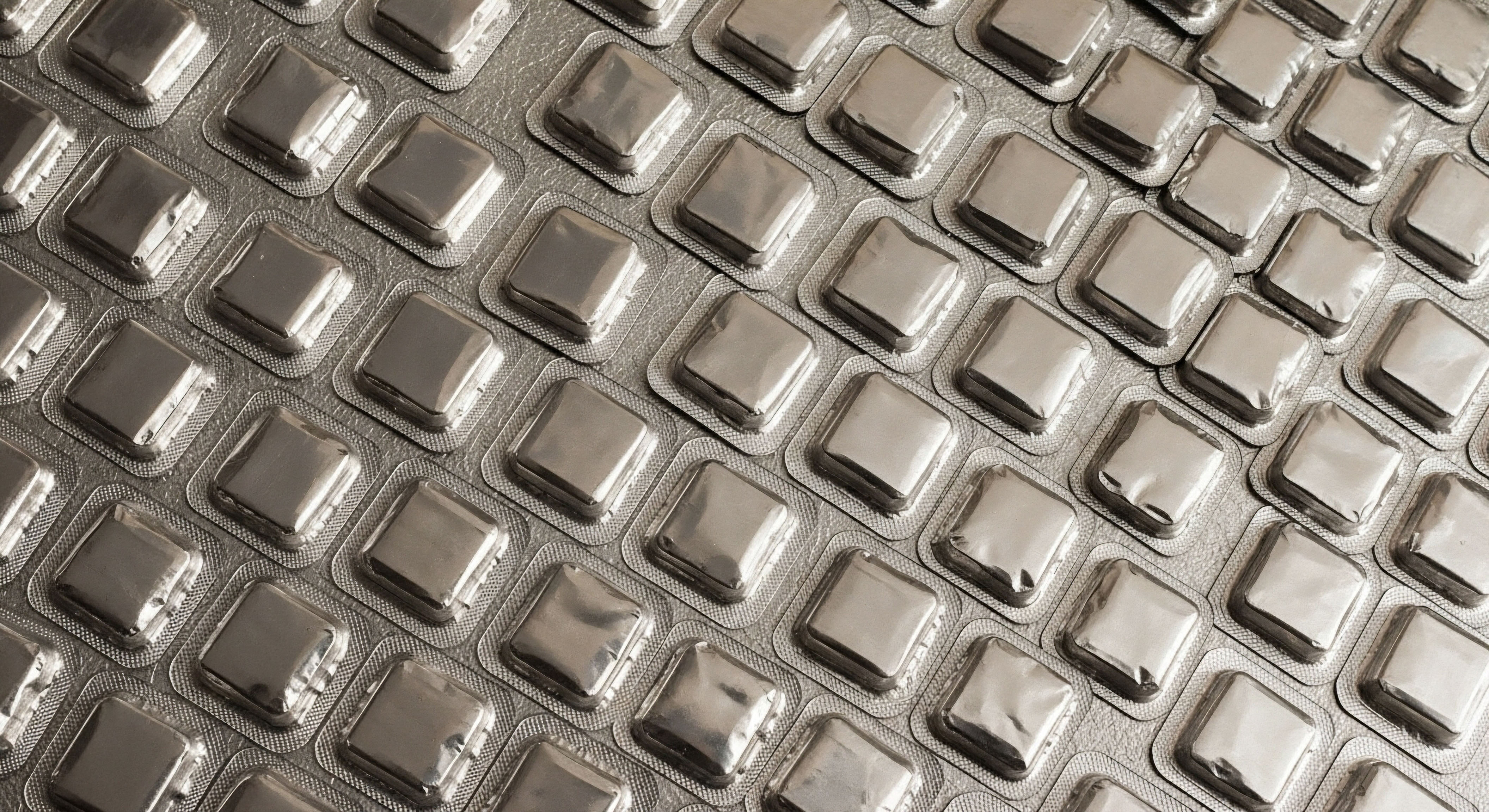

Fundamentals
Experiencing changes in your body, particularly those affecting something as visible as your hair, can bring about a unique sense of unease. Perhaps you have noticed a subtle thinning at the temples, a widening part, or an increased presence of strands on your pillow.
This observation, while seemingly minor, often signals a deeper conversation within your biological systems. It is a signal that prompts introspection, leading many to consider how their internal environment influences their outward vitality. For those navigating the terrain of hormonal optimization, particularly with protocols like Testosterone Replacement Therapy (TRT), the prospect of hair preservation becomes a significant consideration.
Your body operates as an intricate network of chemical messengers, with hormones serving as the conductors of this complex orchestra. These powerful molecules regulate nearly every physiological process, from your energy levels and mood to muscle mass and, indeed, hair growth cycles. When these messengers are out of balance, even subtly, the effects can ripple throughout your system, manifesting in various ways. Understanding this interconnectedness is the initial step toward reclaiming a sense of control over your well-being.
Testosterone Replacement Therapy (TRT) is a therapeutic intervention designed to restore circulating testosterone levels to a physiological range in individuals experiencing symptomatic androgen deficiency. This approach aims to alleviate a spectrum of concerns, including diminished energy, reduced libido, and alterations in body composition. While TRT offers substantial benefits for many, a common concern arises regarding its potential influence on scalp hair density. This concern stems from the body’s natural processes, specifically the conversion of testosterone into a more potent androgen.
The primary mechanism linking testosterone therapy to scalp hair changes involves the enzyme 5-alpha reductase. This enzyme converts testosterone into dihydrotestosterone (DHT), a powerful androgen. For individuals with a genetic predisposition to androgenic alopecia, or pattern baldness, hair follicles on the scalp exhibit heightened sensitivity to DHT. This sensitivity leads to a process known as follicular miniaturization, where hair follicles gradually shrink, producing finer, shorter, and less pigmented hairs over successive growth cycles, eventually ceasing production altogether.
Hair thinning during hormonal optimization often signals the body’s intricate response to androgen metabolism, particularly the conversion of testosterone to DHT in genetically susceptible individuals.
The body’s hormonal systems operate through sophisticated feedback loops, ensuring a delicate balance. When exogenous testosterone is introduced, as in TRT, the body’s natural production of testosterone may decrease, and the conversion to DHT can become more pronounced in certain tissues.
This dynamic underscores the importance of a comprehensive understanding of how these biochemical recalibrations influence various physiological expressions, including the health of your hair follicles. Recognizing this interplay is essential for those seeking to optimize their hormonal health while proactively addressing potential side effects.
Against this backdrop, the concept of peptide therapy emerges as a compelling area of exploration. Peptides are short chains of amino acids, acting as signaling molecules within the body. They are essentially biological messengers, capable of influencing a wide array of cellular processes, including tissue repair, inflammation modulation, and cellular regeneration.
The appeal of peptides lies in their targeted action and their potential to offer non-pharmacological avenues for supporting biological systems. For hair preservation, specific peptides are being investigated for their capacity to interact directly with hair follicle biology, offering a different pathway to mitigate the effects of androgenic influence.


Intermediate
Understanding the intricate relationship between hormonal optimization and hair health requires a deeper examination of the biological pathways involved. While the benefits of Testosterone Replacement Therapy (TRT) for addressing symptoms of androgen deficiency are well-documented, the potential for accelerated hair thinning in genetically predisposed individuals remains a significant consideration.
This phenomenon is primarily mediated by dihydrotestosterone (DHT), a potent androgen derived from testosterone through the action of the 5-alpha reductase enzyme. Hair follicles on the scalp, particularly in areas susceptible to pattern baldness, possess a high concentration of androgen receptors that are highly sensitive to DHT. When DHT binds to these receptors, it initiates a cascade of events leading to the progressive miniaturization of the hair follicle, shortening its growth phase, and ultimately leading to hair loss.
Traditional pharmacological strategies for managing androgenic alopecia often involve inhibiting the 5-alpha reductase enzyme or directly stimulating hair growth. Medications such as finasteride and dutasteride work by blocking the conversion of testosterone to DHT, thereby reducing circulating DHT levels.
While effective for many, these agents can carry their own set of considerations, including potential systemic side effects such as decreased libido or other hormonal alterations. Another common approach involves topical applications like minoxidil, which acts as a vasodilator to improve blood flow to hair follicles and prolong the anagen (growth) phase of the hair cycle. While these conventional treatments offer solutions, many individuals seek alternatives that align with a more holistic or non-pharmacological approach to their wellness protocols.

Can Peptides Offer a Different Path for Hair Preservation?
Peptide therapy presents a distinct avenue for supporting hair health, particularly for those undergoing hormonal optimization. These biologically active molecules operate by signaling specific cellular responses, offering a more targeted and often localized influence compared to systemic pharmacological interventions. The mechanisms through which various peptides support hair preservation are diverse, ranging from enhancing microcirculation to modulating inflammatory responses and directly stimulating hair follicle activity.
One prominent peptide in this context is GHK-Cu, also known as copper tripeptide-1. This naturally occurring peptide complex has garnered considerable attention for its regenerative properties. GHK-Cu is believed to support hair health through multiple pathways.
It promotes angiogenesis, the formation of new blood vessels, which improves blood supply and nutrient delivery to hair follicles, a vital aspect for their sustained growth. Additionally, GHK-Cu exhibits potent anti-inflammatory and antioxidant properties, helping to create a healthier scalp environment by reducing oxidative stress and inflammation that can impede hair growth. Some research also suggests GHK-Cu may influence DHT levels or directly activate hair follicle cells, extending the hair’s growth phase and increasing follicle size.
Other peptides also demonstrate promise in this domain. Biotinoyl Tripeptide-1, for instance, is recognized for its ability to enhance keratin production and reinforce the anchoring of hair shafts, leading to stronger hair structures and reduced shedding. Similarly, Acetyl Tetrapeptide-3 works by strengthening the extracellular matrix around hair follicles, which is the supportive scaffolding that helps maintain hair structure and reduce premature shedding.
These peptides contribute to improved hair density and overall hair quality by fostering a more robust environment for hair growth.
The emerging peptide Follicopeptide, derived from a modified human structural protein called osteopontin, has shown encouraging results in clinical studies for androgenic alopecia. It is designed to enhance hair growth and has demonstrated high safety and a significant response rate in trials, indicating its potential as a targeted solution for both men and women experiencing hair thinning.
Another peptide, PT-141, primarily known for its role in sexual health, has also been observed to influence hair health. Its mechanism involves activating melanocortin receptors, which can help control scalp inflammation and improve vascular support, creating a more conducive environment for hair growth.

Comparing Peptide Actions for Hair Health
| Peptide | Primary Mechanism for Hair Health | Observed Benefits |
|---|---|---|
| GHK-Cu | Promotes angiogenesis, anti-inflammatory, antioxidant, stimulates hair follicle cells, potentially reduces DHT. | Increased hair density, reduced shedding, improved scalp health, extended growth phase. |
| Biotinoyl Tripeptide-1 | Enhances keratin production, reinforces hair anchoring. | Stronger hair shafts, reduced hair loss, increased hair density. |
| Acetyl Tetrapeptide-3 | Strengthens extracellular matrix around hair follicles. | Improved hair anchoring, reduced shedding, increased hair diameter. |
| Follicopeptide | Designed to enhance hair growth, mechanism related to osteopontin. | Growth of new hairs, high response rate in androgenic alopecia. |
| PT-141 | Controls scalp inflammation, improves vascular support via melanocortin activation. | Healthier hair growth environment, potential for reduced scalp inflammation. |
The application of these peptides typically involves topical serums or, in some cases, subcutaneous injections, depending on the specific peptide and clinical protocol. The goal is to deliver these signaling molecules directly to the hair follicles or to influence systemic factors that impact hair health. This approach aligns with a personalized wellness strategy, allowing for targeted interventions that complement broader hormonal optimization efforts.
Peptide therapy offers a non-pharmacological pathway to support hair health during TRT by directly influencing hair follicle biology, modulating inflammation, and enhancing local microcirculation.
Integrating peptide therapy into a hormonal optimization protocol requires careful consideration and professional guidance. It involves understanding the individual’s genetic predispositions, current hormonal status, and overall health profile. The aim is to create a synergistic approach where the benefits of TRT are maximized while proactively addressing potential side effects like hair thinning through complementary, biologically aligned interventions. This comprehensive perspective acknowledges the body’s interconnected systems, striving for optimal function and vitality without compromise.


Academic
The intricate dance of the endocrine system, metabolic pathways, and cellular signaling forms the bedrock of human physiology. When considering hair preservation during Testosterone Replacement Therapy (TRT), a deeper dive into these interconnected systems reveals the sophisticated mechanisms at play.
The prevailing understanding attributes TRT-associated hair thinning, specifically androgenic alopecia, to the conversion of testosterone into dihydrotestosterone (DHT) by the 5-alpha reductase enzyme. However, this explanation, while accurate, represents only one facet of a more complex biological narrative.
The sensitivity of individual hair follicles to DHT, influenced by genetic factors, plays a more significant role than the absolute levels of circulating androgens. This highlights a critical concept ∞ the localized tissue response often dictates the physiological outcome, even in the presence of systemic hormonal shifts.
Hair follicle biology is remarkably dynamic, cycling through distinct phases ∞ anagen (growth), catagen (transition), and telogen (resting/shedding). Androgens, particularly DHT, exert their influence by shortening the anagen phase and accelerating the transition to catagen and telogen, leading to progressive miniaturization of the follicle over time.
This process is not merely a consequence of elevated DHT; it is a manifestation of a genetically programmed follicular susceptibility to androgenic signaling. Furthermore, the broader metabolic and inflammatory landscape of the body can significantly modulate this follicular response. Chronic low-grade inflammation, oxidative stress, and insulin dysregulation can all contribute to a suboptimal environment for hair growth, exacerbating androgen-induced effects.

How Do Peptides Influence Hair Follicle Dynamics?
Peptides, as highly specific signaling molecules, offer a compelling avenue for modulating hair follicle dynamics at a molecular level. Their mechanisms extend beyond simple receptor binding, influencing complex intracellular pathways that govern cell proliferation, differentiation, and tissue repair.
Consider GHK-Cu, a copper-binding tripeptide. Its actions are multifaceted. At a fundamental level, GHK-Cu promotes angiogenesis, the formation of new blood vessels, which is absolutely essential for supplying hair follicles with the necessary oxygen and nutrients for robust growth.
A compromised microvasculature around the hair bulb can severely impair follicular function, regardless of hormonal status. Beyond vascular support, GHK-Cu modulates inflammatory processes. Chronic micro-inflammation in the scalp, often subclinical, can contribute to follicular damage and accelerate miniaturization. GHK-Cu’s anti-inflammatory properties help to quell this detrimental environment, creating a more conducive setting for hair regeneration.
Moreover, GHK-Cu has been shown to influence the Wnt/β-catenin signaling pathway, a critical regulatory cascade for hair follicle development and regeneration. Activation of this pathway is vital for initiating and maintaining the anagen phase of hair growth. By upregulating components of this pathway, GHK-Cu can potentially prolong the growth phase and stimulate dormant follicles.
Its antioxidant capacity also protects hair follicle cells from damage induced by reactive oxygen species, which are implicated in the aging process of hair and scalp.
Other peptides, such as Biotinoyl Tripeptide-1 and Acetyl Tetrapeptide-3, act primarily on the structural integrity of the hair follicle and its surrounding extracellular matrix. Biotinoyl Tripeptide-1 enhances the production of keratin, the primary protein component of hair, and strengthens the adhesion molecules that anchor the hair shaft within the follicle.
Acetyl Tetrapeptide-3 contributes to the integrity of the dermal papilla, a crucial signaling center for hair growth, by stimulating the synthesis of extracellular matrix proteins like collagen and laminin. This structural reinforcement helps to resist the miniaturizing effects of androgens and mechanical stress.
The novel Follicopeptide, derived from osteopontin, represents a targeted approach. Osteopontin is a glycoprotein involved in various biological processes, including inflammation and tissue remodeling. Its presence in hair follicles suggests a role in their physiological function. Follicopeptide’s efficacy in androgenic alopecia, as demonstrated in clinical studies, points to its ability to directly stimulate new hair growth, potentially by influencing local growth factors or cellular communication within the follicle microenvironment.

Interplay of Hormonal Balance and Peptide Action
The decision to pursue TRT often stems from a desire to restore systemic hormonal balance and improve overall vitality. However, the body’s response to exogenous testosterone is not monolithic. The individual variability in 5-alpha reductase activity and androgen receptor sensitivity means that even within physiological testosterone ranges, some individuals may experience accelerated hair thinning. This is where the integration of peptide therapy offers a sophisticated, non-pharmacological adjunct.
Rather than solely relying on systemic DHT inhibition, which can have broader hormonal implications, peptides offer a localized or targeted intervention. They work by enhancing the intrinsic regenerative capacity of the hair follicle and optimizing its microenvironment. This approach respects the body’s complex feedback mechanisms, providing support where it is most needed without disrupting the broader endocrine recalibration achieved through TRT.
For instance, while TRT aims to optimize systemic testosterone levels, peptides like GHK-Cu can directly improve blood flow to the scalp and reduce localized inflammation, factors that are independent of systemic androgen levels but are critical for hair health. This dual approach addresses both the systemic hormonal milieu and the specific follicular response, creating a more robust strategy for hair preservation.
The concept of growth hormone peptide therapy also holds relevance for overall tissue health, including hair. Peptides such as Sermorelin, Ipamorelin/CJC-1295, and MK-677 stimulate the pulsatile release of growth hormone (GH) from the pituitary gland.
While not directly targeting hair follicles in the same manner as GHK-Cu, optimized GH levels can improve cellular regeneration, collagen synthesis, and overall tissue repair throughout the body, indirectly supporting hair health and vitality. This systemic support contributes to a healthier physiological foundation upon which hair can thrive.

Considering the Regulatory Landscape for Peptide Therapies
The application of peptide therapies, particularly as non-pharmacological alternatives, necessitates a thorough understanding of their regulatory status and clinical evidence. While many peptides demonstrate promising biological activities in preclinical and early clinical studies, their widespread adoption and availability depend on rigorous scientific validation and regulatory approval processes. The distinction between research-grade peptides and pharmaceutical-grade compounds is paramount.
For example, in some regions, certain peptides may be available through compounding pharmacies for specific clinical applications under a physician’s guidance, while in others, they may still be considered investigational. This variability underscores the importance of consulting with healthcare providers who possess deep expertise in both endocrinology and peptide science.
They can navigate the current landscape, ensuring that any therapeutic protocol is not only evidence-based but also legally and ethically sound. The ongoing research into peptides continues to expand our understanding of their therapeutic potential, paving the way for more refined and targeted interventions in personalized wellness.
- Follicular Miniaturization ∞ The process where hair follicles shrink over time, producing thinner, shorter hairs, eventually leading to cessation of hair growth. This is a hallmark of androgenic alopecia.
- Androgen Receptor Sensitivity ∞ The degree to which hair follicles respond to androgens like DHT. High sensitivity, rather than just high DHT levels, is a key determinant of hair loss.
- Wnt/β-catenin Pathway ∞ A crucial signaling pathway involved in cell proliferation, differentiation, and tissue regeneration, including hair follicle development and cycling.
- Extracellular Matrix (ECM) ∞ The non-cellular component of tissues that provides structural support and biochemical cues to cells. A healthy ECM around hair follicles is vital for their integrity.
The journey toward optimal health is a deeply personal one, often requiring a willingness to explore beyond conventional approaches. For those seeking to preserve hair density while undergoing hormonal optimization, peptide therapy offers a scientifically grounded, non-pharmacological alternative. By understanding the intricate interplay of hormones, genetics, and cellular signaling, individuals can make informed decisions that align with their wellness goals, fostering a renewed sense of vitality and confidence.

References
- Ellis, J. A. Stebbing, M. & Harrap, S. B. (2001). Genetic analysis of male pattern baldness and the 5alpha-reductase type 2 gene. Journal of Investigative Dermatology, 116(3), 447-450.
- Kwon, O. S. et al. (2012). The effect of copper-binding peptide GHK-Cu on hair growth in vitro. Journal of the Korean Medical Science, 27(11), 1334-1338.
- Inui, S. & Itami, S. (2013). Androgen actions on hair follicles ∞ its clinical implications. Clinical and Experimental Dermatology, 38(6), 591-596.
- Pattnaik, S. et al. (2021). Follicopeptide ∞ A novel peptide for the treatment of androgenetic alopecia. Dermatologic Therapy, 34(4), e14995.
- Zhou, X. et al. (2020). GHK-Cu promotes hair growth through Wnt/β-catenin signaling pathway activation. Journal of Dermatological Science, 97(1), 54-60.
- Veldhuis, J. D. et al. (2006). Physiological regulation of the human growth hormone (GH)-insulin-like growth factor I (IGF-I) axis ∞ a review. Growth Hormone & IGF Research, 16(Suppl A), S1-S14.
- Rossi, A. et al. (2016). Comparative analysis of efficacy and safety of finasteride and dutasteride in the treatment of androgenetic alopecia ∞ a systematic review. Journal of the American Academy of Dermatology, 74(6), 1204-1210.

Reflection
As you consider the intricate details of hormonal health and the potential of peptide therapies, perhaps a new perspective on your own biological systems begins to take shape. This exploration is not merely about addressing a symptom like hair thinning; it represents an invitation to understand the profound interconnectedness within your body. Each piece of knowledge gained, whether about androgen metabolism or cellular signaling, contributes to a more complete picture of your unique physiology.
Your personal health journey is a continuous process of discovery and recalibration. The insights shared here serve as a starting point, a foundation upon which to build a deeper relationship with your own vitality. True wellness arises from this informed self-awareness, guiding you toward choices that honor your body’s innate intelligence. Consider this information a catalyst for further dialogue with trusted healthcare professionals, allowing for the creation of a truly personalized path forward.

What Does a Personalized Approach to Hair Preservation Mean for You?
The path to optimal well-being is rarely a one-size-fits-all solution. Your unique genetic makeup, lifestyle, and individual response to hormonal changes all play a role in how your body expresses itself. This understanding empowers you to move beyond generic recommendations, seeking out strategies that are precisely tailored to your needs.
The integration of advanced therapies, such as peptides, within a broader framework of hormonal optimization exemplifies this personalized approach. It is about aligning your external goals with your internal biological realities, fostering a state of sustained health and confidence.



